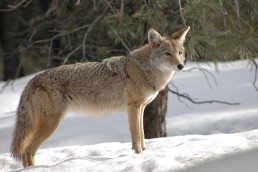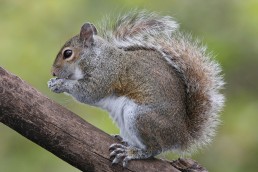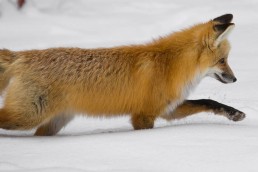Adapt to Early-winter Patterns to Bag a Late Whitetail
SHARE THIS POST
Remember when you were crossing days off the calendar in anticipation for archery opener?
Then, the season opened and weeks went by in a blur and now it’s early winter. The season is coming to an end in a few, short weeks. Maybe you took a doe early and are focusing on getting a buck. Maybe your zone only allows one buck with antler restrictions and the big boy hasn’t shown his face. Whatever has kept you in the chase this long, late-season whitetail hunting can be its own special time, with its own rhythm and rules.
Success at this season comes from understanding where deer are in their annual cycle, and putting yourself in the right spot. Then, of course, making a good shot.
Find the food, find the deer
Understanding what deer eat, and when, is just as critical as being in the right stand with the right wind. As temps drop, deer become less nocturnal, giving hunters the chance at a perfect well-lit kill shot. Preparing to withstand winter, deer continuously graze in order to add layers of stored energy. Food plots bearing beans, brassicas, and corn can be the key to colliding with the buck you are after during daylight hours.
At this time of year, deer typically remain in the woods as long as possible to feed on grasses, berries, and acorns. However, due to widespread frost this past May, there have been a lack of acorns in some Midwestern states, leading deer to search for other food sources.
“Deer are ruled by their stomachs,” says Tim Neuman, wildlife biologist for Anilogics. “They need extra energy from grains. If I had to pick hunting over beans or corn, I would choose beans. Standing beans are short enough that a hunter can still see the vital organs on a whitetail when it is grazing, too, a big bonus when you’re trying to shoot.”
Are you enjoying this post?
You can be among the first to get the latest info on where to go, what to use and how to use it!
Dress for it
Late-season hunting brings cold weather that often challenges your hunt. Preparation is key. Wearing too many layers will keep you warm on your walk to the stand, but will leave you drenched with sweat when you arrive at your destination. Not layering enough will be a guaranteed short sit. Ideally, wearing a base layer or next-to-skin, plus a lightweight insulating top and bottom, allows breathability and the option to add more clothing when you arrive at your hunting location. Be prepared by packing gloves, a pair of bibs, and a shell in your pack. Your chances of bagging a deer are much better if you are sitting in the stand and make a little noise getting clothes on, rather than lying on the couch due to inclement weather.
Vary your pattern
In the season’s final days, try changing your hunting pattern. Most people hunt early morning for a few hours, head home, and come back to the stand an hour or two before sunset. Studies show predominant late-season deer movement happens between 10 a.m. and 2 p.m. As hunters leave their stands, nearby deer leave their bedding area for safety. Staying in the stand until 2 p.m. significantly increases the odds of spotting deer that are on their midday feeding pattern.
When you decide to leave the woods for a bit, be alert at all times. Instead of making a beeline to the vehicle, strategize your exit. Whitetails typically stay in close proximity to their bedding area while grazing during the day, so travel a different path on the way back. Check swamps, fencerows, and brush piles. If you created a mock scrape, pass by that area as well. Using a time-released scent container over mock scrapes keeps the dominant bucks on their feet and continuously coming back to check the scrape. Deer use mock scrapes all year, so set up a trail camera and pattern their movement times.
Seal the deal
An unfilled deer tag is a lonely thing. Snow, wind, rain, or beautiful winter day, the woods and fields are loaded with life. Layer up, find a late-season food source, and adapt to what the deer are doing right now. Stay on the hunt until you run out of time or find yourself with the welcome labor of dragging out your final harvest for this season. Those backstraps will taste better than ever, and you will be very satisfied with yourself.
Alison Marie was born and raised in southern Minnesota, where she runs Rack ‘em Guide Service. You can find her in the woods and fields chasing ducks, geese, deer, and turkeys, or on the water fishing. Her day job is at USDA Natural Resources Conservation Service, helping people help the land. She’s President of St. Charles chapter of Whitetails Unlimited.
MWO
SHARE THIS POST
Did you enjoy this post?
You can be among the first to get the latest info on where to go, what to use and how to use it!
Alison Marie
Alison Marie was born and raised in southern Minnesota, where she runs Rack ‘em Guide Service. You can find her in the woods and fields chasing ducks, geese, deer, and turkeys, or on the water fishing. Her day job is at USDA Natural Resources Conservation Service, helping people help the land. She’s President of St. Charles chapter of Whitetails Unlimited.



